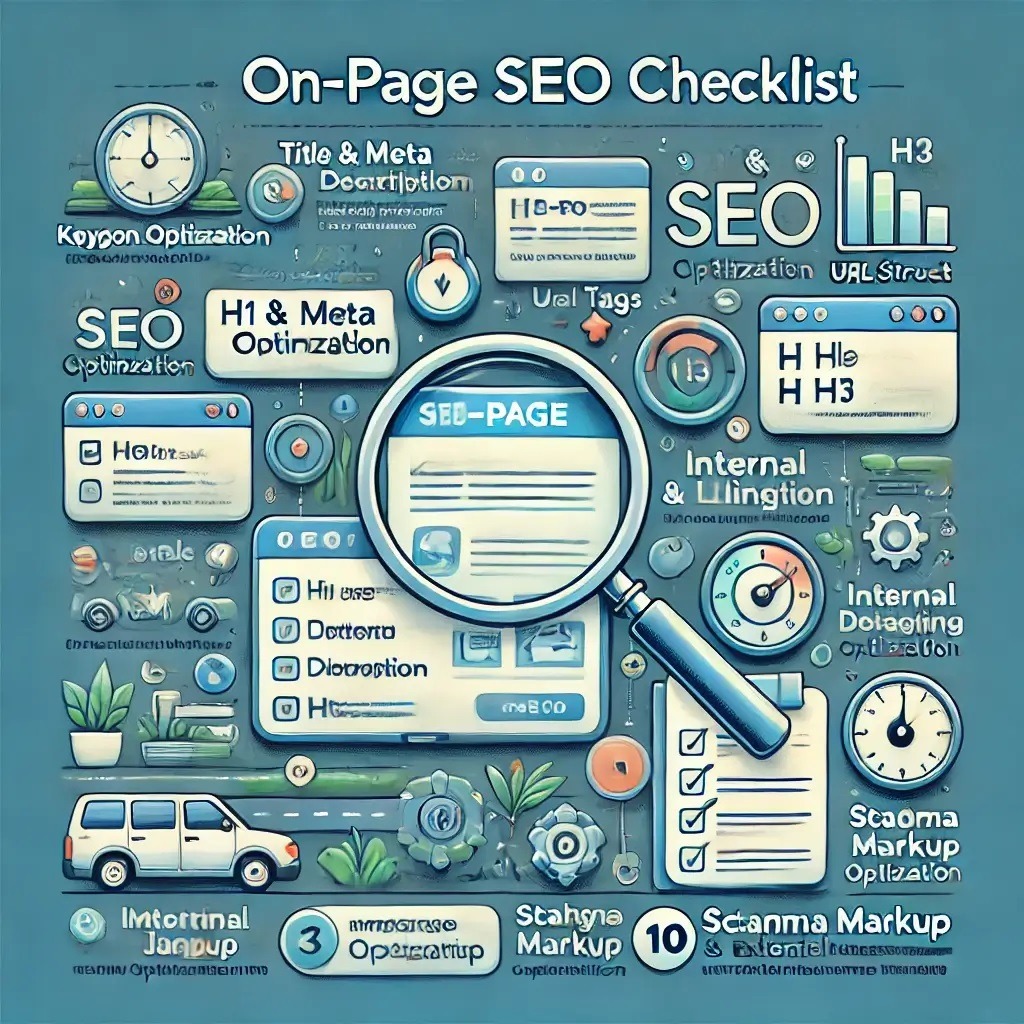
If you want your website to rank higher on search engines and attract more visitors, you need to focus on On-Page SEO. It plays a crucial role in optimizing individual pages for better visibility and user experience. In this guide, I’ll walk you through a complete On-Page SEO Checklist with step-by-step details and real-life examples.
1️⃣ Keyword Optimization
Why It’s Important: Keywords help search engines understand your content and rank it accordingly.
How to Optimize Keywords:
✅ Use the primary keyword naturally in the title, URL, first 100 words, and headings.
✅ Include long-tail keywords and variations to capture more searches.
✅ Avoid keyword stuffing; keep a natural flow (1-2% keyword density is ideal).
Example:
If your article is about “Best Digital Marketing Strategies,” optimize it like this:
- Title: “Best Digital Marketing Strategies to Grow Your Business in 2024”
- First Paragraph: “Implementing the best digital marketing strategies is crucial for business growth.”
- Subheadings: “Top Digital Marketing Strategies for Startups”
2️⃣ Title & Meta Description Optimization
Why It’s Important: These elements impact CTR (Click-Through Rate) and search rankings.
Best Practices:
✅ Keep titles under 60 characters and include the primary keyword.
✅ Write engaging meta descriptions (under 160 characters) to attract clicks.
Example:
- Title: “10 Effective On-Page SEO Techniques for Higher Rankings”
- Meta Description: “Boost your rankings with these 10 proven on-page SEO techniques. Learn how to optimize content, images, and more!”
3️⃣ URL Structure
Why It’s Important: Clean URLs improve readability and rankings.
Best Practices:
✅ Use short, descriptive URLs with the main keyword.
✅ Avoid special characters, numbers, or unnecessary words.
✅ Use hyphens (-) instead of underscores (_).
Example:
❌ Bad: www.example.com/p=12345 ✅ Good: www.example.com/on-page-seo-checklist
4️⃣ Header Tags (H1, H2, H3, etc.)
Why It’s Important: Header tags help organize content and improve user experience.
Best Practices:
✅ Use H1 for the title, H2 for main sections, and H3 for subpoints.
✅ Naturally include keywords in some headings.
Example:
H1: “The Ultimate On-Page SEO Guide” H2: “Why On-Page SEO Matters” H3: “How It Impacts Google Rankings”
5️⃣ Content Optimization
Why It’s Important: Quality content is key to higher rankings and user engagement.
Best Practices:
✅ Write at least 1,000+ words for comprehensive coverage.
✅ Use bullet points, short paragraphs, and visuals to improve readability.
✅ Answer common questions to optimize for Featured Snippets.
Example:
Instead of: ❌ “SEO is important for websites because it helps them rank higher in search engines.”
Write: ✅ “SEO plays a crucial role in increasing website rankings, improving visibility, and driving more organic traffic.”
6️⃣ Image Optimization
Why It’s Important: Optimized images improve page speed and accessibility.
Best Practices:
✅ Use descriptive file names (e.g., on-page-seo-checklist.png).
✅ Add alt text with relevant keywords.
✅ Compress images using TinyPNG or ShortPixel for faster loading.
Example:
❌ Bad Alt Text: “Image1234” ✅ Good Alt Text: “On-Page SEO Checklist for 2024”
7️⃣ Internal & External Linking
Why It’s Important: Links help search engines understand page relationships and increase authority.
Best Practices:
✅ Internal Links – Link to relevant pages on your site.
✅ External Links – Link to high-authority sources for credibility.
Example:
📌 “For a deeper understanding of keyword research, check out our guide on Keyword Research for SEO.”
8️⃣ Mobile-Friendliness
Why It’s Important: Google prioritizes mobile-friendly websites.
Best Practices:
✅ Test with Google’s Mobile-Friendly Test.
✅ Avoid intrusive pop-ups that affect usability.
✅ Ensure responsive design that adapts to all devices.
9️⃣ Page Speed Optimization
Why It’s Important: A slow website leads to high bounce rates.
Best Practices:
✅ Use Google PageSpeed Insights to analyze speed.
✅ Compress images and enable lazy loading.
✅ Minify CSS, JavaScript, and HTML.
Example:
- Before Optimization: 5+ seconds load time
- After Optimization: Under 2 seconds
🔟 Schema Markup & Technical SEO
Why It’s Important: Schema markup helps search engines display rich snippets.
Best Practices:
✅ Implement FAQ Schema for better visibility.
✅ Use Product Schema for eCommerce websites.
Example:
A blog post with FAQ Schema might show this on Google:
- Q: What is On-Page SEO?
- A: On-Page SEO is the practice of optimizing web pages for better search rankings.
✅ Bonus: User Experience (UX) & Engagement
Why It’s Important: A great UX keeps visitors engaged and reduces bounce rates.
Best Practices:
✅ Keep the website design simple and easy to navigate.
✅ Improve readability with short sentences and clear fonts.
✅ Add interactive elements like polls, comment sections, or social sharing buttons.
Example:
📌 A well-structured homepage should be fast, clutter-free, and easy to navigate.
Following this On-Page SEO Checklist will help your website rank higher, attract more organic traffic, and improve user engagement. 🚀
Do you have any On-Page SEO strategies that work best for you? Share your thoughts in the comments!
Tags: On-Page SEO Checklist
Very informative article. The step-by-step breakdown of title tags, meta descriptions, and content optimization is spot on. Perfect for beginners and pros alike.
This is a very comprehensive on-page SEO checklist. Adding example formats for schema types or sample content templates in the next update would make it even more valuable. Overall, great job!
Great article! The on-page SEO checklist is very well-structured and easy to follow. I especially liked the detailed examples for title tags, meta descriptions, and internal linking. This is a solid resource for both beginners and professionals looking to improve their optimization workflow.
Loved this! The examples made complex SEO concepts simple and practical. On-page SEO is often overlooked, so having a checklist like this really helps stay consistent. Thanks for sharing such valuable insights!
Super helpful checklist! Clear, actionable, and perfect for improving on-page SEO. Thanks for the detailed examples!
This is one of the most practical on-page SEO checklists I’ve seen. Real examples + actionable tips = perfect combination!